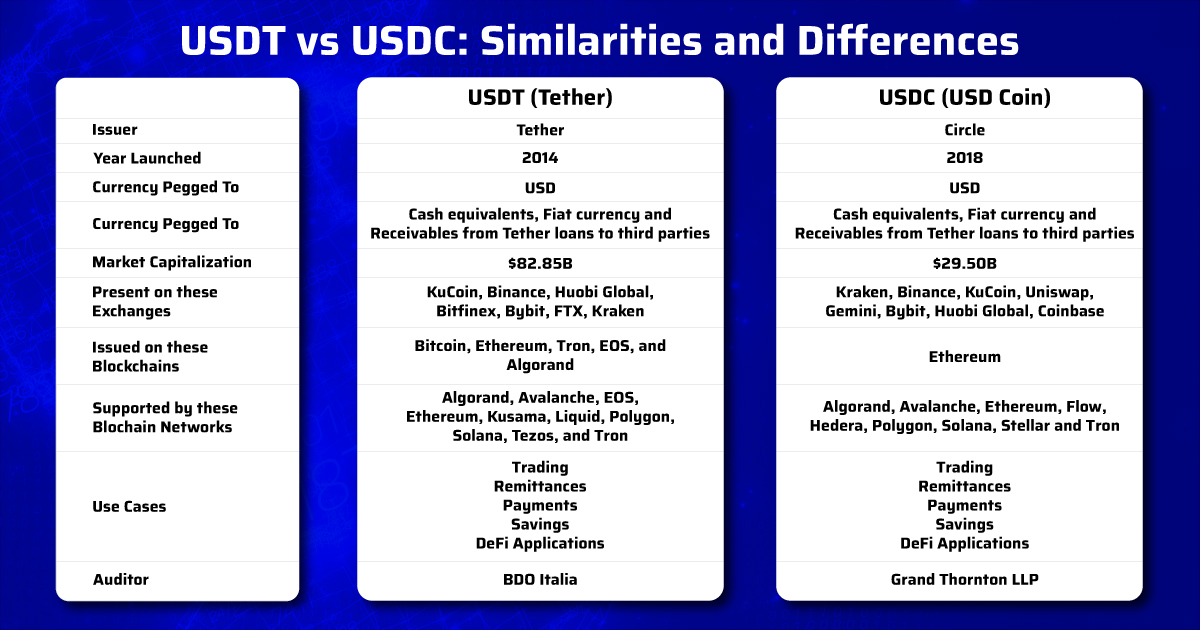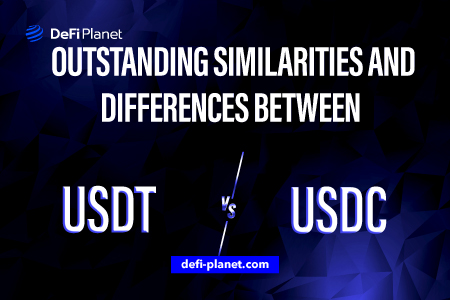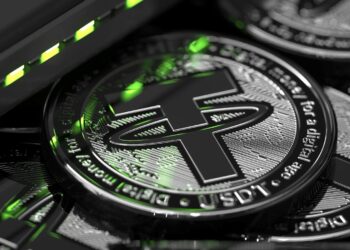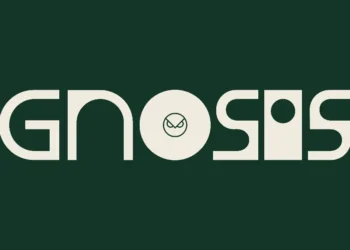Cryptocurrencies have gained recognition as a promising substitute for conventional currencies, although their volatility has sparked legitimate concerns. However, a solution has emerged in the form of stablecoins, a novel development within the crypto industry. Stablecoins are specifically designed to tackle the volatility issues commonly associated with traditional cryptocurrencies.
These blockchain-based tokens are “pegged” to a stable asset such as gold or fiat currency. This pegging mechanism ensures they maintain a consistent value, offering users a reliable means to store and exchange value without worrying about sudden price changes.
Two of the most popular stablecoins, USDT and USDC, are widely used and operate on a similar model to ensure the tokens in circulation are backed by equivalent reserves. Tether (USDT), was among the first stablecoins introduced and has become one of the most valuable stablecoins by market value. USD Coin (USDC) was launched by Circle in 2018 and has also gained significant traction.
This article provides a comprehensive overview of USDT and USDC, highlighting their similarities and differences. By gaining a thorough understanding of the strengths and weaknesses of these stablecoins, users and investors can make informed decisions about which one is better suited to their individual needs.
Brief Overview of USDT & USDC
USDT and USDC are fiat-backed stablecoins pegged to the US dollar at a 1:1 ratio and less volatile than other cryptocurrencies like Bitcoin (BTC) and Ether (ETH). They offer fast, low-cost, and secure transactions on the blockchain, effectively bypassing the typical obstacles associated with traditional financial systems.
The rise of these tokens to dominance in the crypto market has been relatively rapid but punctuated. Let’s delve into the factors that contributed to the prominence of these stablecoins.
Tether (USDT): The Emergence of the First Stablecoin
Tether Limited introduced USDT in 2014 as the first stablecoin, and it has since grown to become the most popular trading pair in the crypto market. USDT offers a blockchain-based version of the US dollar that is stable and easily tradable, reducing risks compared to other volatile cryptocurrencies.
Tether facilitated a permissionless way to send ‘crypto dollars’ quickly, transparently, and cheaply”. It expanded the use of cryptocurrencies to include remittances, payments, and more applications
USDT’s Opaque Nature
Despite successfully achieving its goals of providing stability and reducing volatility in the crypto market, Tether faced a big problem fundamental to the definition of cryptocurrencies: transparency. The stablecoin was heavily criticized for being ‘opaque.’
Tether Limited, the company issuing USDT, came under fire for failing to provide clear information regarding the US dollar backing of USDT. While Tether Limited claimed that each USDT is backed by an equivalent US dollar held in reserve, independent auditors were not granted full access to the company’s bank accounts to verify this claim. This lack of transparency raised doubts about whether Tether Limited had sufficient US dollars in reserves to fully back all circulating USDT.
Also, USDT’s anonymity raised concerns about its potential use for money laundering, financing terrorism, and other illegal activities. Although the transactions are recorded on a public blockchain, the identities of those involved are not publicly disclosed.
Transparent Stablecoins? How USDC Rose to Rival USDT
In 2018, a wave of new stablecoins hit the crypto market, hoping to capitalize on USDT’s shortcomings. Among these, USDC, developed through a partnership between Circle and Coinbase, proved to be the most successful. Other stablecoins in this wave include Gemini Dollar, Paxos Standard Token (now called Pax Dollar), and True USD.
What is USDC?
USDC was designed to closely resemble USDT, which is backed by reserves held by its issuer, with the objective of maintaining a value as close to one US dollar as possible. Customers have the option to deposit US dollars to Circle and receive an equivalent amount of USDC tokens. Likewise, they can exchange their USDC for US dollars at a 1:1 ratio through Circle.
Circle is the primary entity associated with USDC; being responsible for its issuance and the development of payment solutions based on the stablecoin. Since the launch of USDC, Circle has provided monthly attestations from Grant Thornton LLP to demonstrate it has sufficient reserves to back all USDC tokens in circulation. As of December 2022, the reserves primarily consist of cash and short-term US Treasury bonds.
USDC’s transparent approach to its reserves has made it a popular alternative to USDT. While it was initially launched on the Ethereum blockchain, it is now supported on other blockchain platforms like Solana, Algorand, and Stellar.
USDT vs. USDC: Similarities and Differences
While USDT and USDC share many similarities, they also possess distinct characteristics that cater to specific use cases. The table provides a concise overview of the similarities and differences between these two stablecoins.

Use Cases
Both USDT and USDC were designed to give users a secure, low-volatility asset that could be used for transactions, trading, and other activities. The following are some of the uses for USDT and USDC:
- Trading: USDT and USDC are commonly utilized on cryptocurrency exchanges for buying or selling other cryptocurrencies. Their stable value eliminates concerns about frequent price fluctuations in cryptocurrency markets..
- Remittances: Both USDT and USDC offer a quick and cost-effective means to transfer value across borders. As digital assets, they bypass the need for intermediaries like banks or remittance providers.
- Decentralized Finance (DeFi): USDT and USDC find extensive usage within the DeFi ecosystem, often serving as collateral or providing liquidity to lending and borrowing protocols.
- Payments: USDT and USDC can be used for making payments to businesses and service providers that accept cryptocurrency payments. They offer a more reliable payment method compared to other cryptocurrencies, which can experience value fluctuations.
- Savings: Similar to holding US dollars in a bank account, USDT and USDC can be used as a store of value. As digital assets, they don’t require a physical bank account for maintenance or access.
Issuer
Tether Limited is the issuer of USDT, while Circle issues USDC.
Tether Limited has faced controversy regarding concerns about the stablecoin’s reserve backing and financial transparency. There have been allegations of market manipulation by Tether, and critics have expressed doubts about the company’s ability to fully back all circulating USDT with reserves. Nevertheless, Tether has consistently asserted that all USDT tokens are fully backed, and in recent years, has made efforts to enhance transparency and comply with regulations.
On the other hand, Circle is a licensed financial technology firm that collaborates with banks and financial institutions. Circle has received praise for its transparency and regulatory compliance. USDC is backed by USD reserves held in separate accounts. As a result, USDC is widely perceived as having a more transparent and reliable reserve backing compared to USDT.
Decentralization
USDT is issued on multiple blockchains, including Bitcoin, Ethereum, Tron, EOS, and Algorand. This arrangement connects its security and functionality to these networks. While it offers some decentralization, it also exposes USDT to the risks and limitations of the underlying blockchains.
In contrast, USDC is exclusively issued on Ethereum, a widely used and popular blockchain known for its higher degree of decentralization. Therefore, individuals who prioritize decentralization and security may find USDC more appealing.
Liquidity
Both USDT and USDC are highly liquid stablecoins that can be easily bought, sold, and used in various transactions on cryptocurrency exchanges. However, USDT enjoys broader support from exchanges and platforms, along with a higher market capitalization. As a result, it may be more convenient to trade and use USDT in certain situations compared to USDC.
Conversely, USDC has gained significant popularity within the DeFi (Decentralized Finance) community and is increasingly utilized in numerous decentralized applications (dApps). This trend opens up new possibilities for trading and liquidity.
Regulation
Although US regulators do not currently consider either stablecoin as a security, USDC was specifically designed to comply with US anti-money laundering (AML) and know-your-customer (KYC) laws. Its issuer, Circle, is a regulated financial technology company.
Users concerned about regulatory compliance and prefer a stablecoin that closely follows traditional financial regulations may prefer USDC.
On the contrary, USDT has come under regulatory scrutiny regarding its reserve backing and potential for market manipulation.
Is It Safe to Hold USDC or USDT?
Many individuals view USDC as a more secure investment compared to USDT. USDT is backed by cash equivalents, traditional currency, and receivables from Tether loans to third parties. This backing is not as transparent as USDC’s approach, which involves complete collateralization through a reserve of US dollars held in segregated accounts and government bonds.
Furthermore, USDC undergoes regular audits, with Centre now publishing attestations from an external accounting firm to ensure transparency regarding the reserves supporting USDC.
Nevertheless, like any asset, holding USDC still entails certain risks. As USDC is tied to the US dollar, there is a potential for a decline in the value of the US currency itself. Another risk is the possibility of losing confidence in the USDC issuer, Circle, or Centre, the token’s governance consortium.
Despite concerns surrounding its issuer, USDT has managed to maintain its peg, fluctuating between a high of $1.0020 and a low of $0.9959 over the past year. Although slightly more volatile than USDC, USDT has generally remained close to the $1.00 peg.
Consequently, holding USDT can be considered relatively safe due to its limited volatility compared to other cryptocurrencies. However, it is crucial to be mindful of the risks associated with holding USDT.
- First, there have been issues with USDT’s reserve and transparency. There have been questions over whether Tether Limited has enough reserves to back all USDT stablecoins in circulation. Consequently, rumours have surfaced suggesting that USDT may not be entirely backed by US dollars, which could result in a loss of value if the market loses faith in USDT.
- Also, there is no official control or oversight for USDT or its operations as it is not subject to any government regulation. This lack of regulation leaves it prone to fraud or poor management.
In summary, the safety of holding USDT or USDC depends on your personal risk tolerance and investment objectives. If you are comfortable with the potential risks and possess a thorough understanding of how the stablecoin operates, holding USDT could be a viable option. However, it is crucial to conduct thorough research and consult with a financial expert before making any investment decisions.
Alternatives to USDT and USDC
Centralized stablecoins
An excellent example of this is BUSD (Binance USD), which is issued by Paxos and regulated by the New York State Department of Financial Services (NYDFS). Similar to USDC, monthly attestation reports on the reserves backing BUSD are publicly accessible. It’s important to note, however, that Paxos has, since February 2023, stopped minting new BUSD tokens at the direction of the NYDFS.
Overcollateralized crypto-backed stablecoins
Overcollateralized crypto-backed stablecoins, like DAI, offer another approach. DAI is backed by a diverse range of assets, including USDC, and operates through blockchain-based smart contracts, ensuring high transparency. However, it’s important to note that DAI, like other stablecoins, is susceptible to significant market fluctuations, which can lead to a substantial decline in the assets supporting the stablecoin.
Algorithmic stablecoins
Algorithmic stablecoins, like Terra (UST), operate differently from USDT and USDC. They lack full asset backing and instead rely on supply adjustment mechanisms to maintain their target peg. While these stablecoins may offer attractive interest rates, their value can be wiped out within a few days, as demonstrated by the Terra incident. If you prioritize security, it’s advisable to avoid algorithmic stablecoins
In Conclusion,
- With the continuous growth and evolution of the cryptocurrency market, stablecoins such as USDT and USDC have emerged as promising alternatives to conventional currencies, offering stability and security in the highly volatile world of cryptocurrencies.
- While both stablecoins are pegged to the US dollar and serve similar purposes with regard to usability and liquidity, there are distinct differences that may make one more appropriate for specific requirements.
- When deciding between USDT and USDC, investors and users should take into account their risk tolerance, investment objectives, and preference for transparency.
Disclaimer: This article is intended solely for informational purposes and should not be considered trading or investment advice. Nothing herein should be construed as financial, legal, or tax advice. Trading or investing in cryptocurrencies carries a considerable risk of financial loss. Always conduct due diligence.
If you would like to read more articles like this, visit DeFi Planet and follow us on Twitter, LinkedIn, Facebook, Instagram, and CoinMarketCap Community.
“Take control of your crypto portfolio with MARKETS PRO, DeFi Planet’s suite of analytics tools.”























